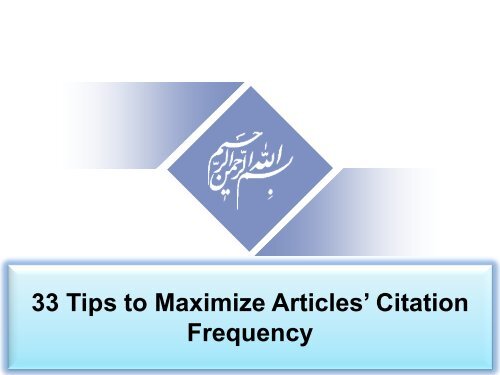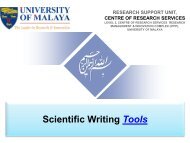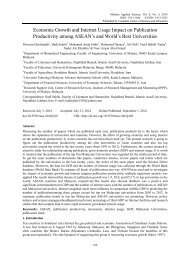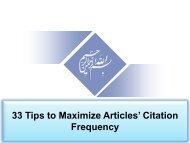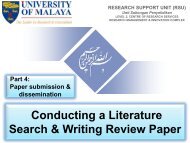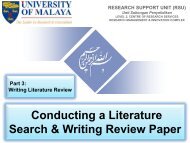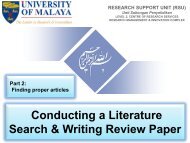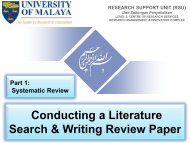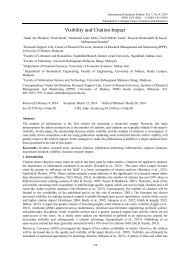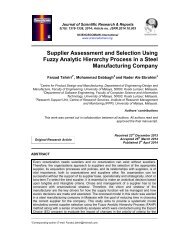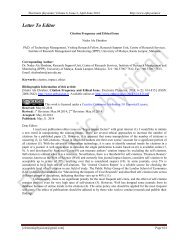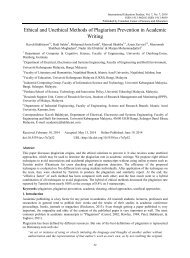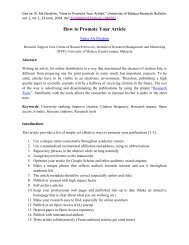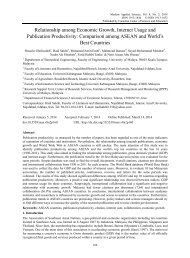33 Tips to Maximize Articles’ Citation Frequency
The number of citations contributes to over 30% in the university rankings. Therefore, most of the scientists are looking for an effective method to increase their citation record. On the other hand, increase research visibility in the academic world in order to receive comments and citations from fellow researchers across the globe, is essential. Publishing a high quality paper in scientific journals is only the mid point towards receiving citation in the future. The balance of the journey is completed by disseminating the publications by using the proper “Research Tools”. This presentation provides 33 different tips for increasing the citation frequencies.
The number of citations contributes to over 30% in the university rankings. Therefore, most of the scientists are looking for an effective method to increase their citation record. On the other hand, increase research visibility in the academic world in order to receive comments and citations from fellow researchers across the globe, is essential.
Publishing a high quality paper in scientific journals is only the mid point towards receiving citation in the future. The balance of the journey is completed by disseminating the publications by using the proper “Research Tools”. This presentation provides 33 different tips for increasing the citation frequencies.
Create successful ePaper yourself
Turn your PDF publications into a flip-book with our unique Google optimized e-Paper software.
<strong>33</strong> <strong>Tips</strong> <strong>to</strong> <strong>Maximize</strong> <strong>Articles’</strong> <strong>Citation</strong><br />
<strong>Frequency</strong>
<strong>33</strong> <strong>Tips</strong> <strong>to</strong> <strong>Maximize</strong> <strong>Articles’</strong> <strong>Citation</strong><br />
<strong>Frequency</strong><br />
Read more: Ale Ebrahim, N., Salehi, H., Embi, M. A., Habibi Tanha, F., Gholizadeh, H., Motahar, S. M., & Ordi, A. (2013). Effective Strategies<br />
for Increasing <strong>Citation</strong> <strong>Frequency</strong>. International Education Studies, 6(11), 93-99. doi: 10.5539/ies.v6n11p93<br />
Nader Ale Ebrahim, PhD<br />
BSc (Mech. Eng., Tehran), MSc (Mech. Eng., Tehran), PhD (Tech. Mang., UM)<br />
==============================<br />
Visiting Research Fellow<br />
Research Support Unit<br />
Centre of Research Services<br />
Research Management & Innovation Complex<br />
University of Malaya, Kuala Lumpur, Malaysia<br />
www.researcherid.com/rid/C-2414-2009<br />
http://scholar.google.com/citations<br />
http://works.bepress.com/aleebrahim/
Abstract<br />
Abstract:<br />
The number of citations contributes <strong>to</strong> over 30% in the university<br />
rankings. Therefore, most of the scientists are looking for an effective<br />
method <strong>to</strong> increase their citation record. On the other hand, increase<br />
research visibility in the academic world in order <strong>to</strong> receive comments<br />
and citations from fellow researchers across the globe, is essential.<br />
Publishing a high quality paper in scientific journals is only the mid<br />
point <strong>to</strong>wards receiving citation in the future. The balance of the journey<br />
is completed by disseminating the publications by using the proper<br />
“Research Tools”. This presentation provides <strong>33</strong> different tips for<br />
increasing the citation frequencies.<br />
Keywords: H-index, Improve citations, Research <strong>to</strong>ols, Bibliometrics,<br />
University ranking, Research impact.<br />
©2014 Nader Ale Ebrahim
Outline<br />
• Motivation<br />
• Definition of h-index<br />
• Predicting scientific success<br />
• New perspective of research impact<br />
• Strategies for enhancing the impact of research<br />
• Preparing for Publication<br />
– Writing<br />
– Collaboration & Journal Selection<br />
• Disseminate Publications<br />
©2014 Nader Ale Ebrahim
Motivations<br />
Times Higher Education World University Ranking system<br />
The Times Higher Education World University Rankings 2012-2013 are the only global university performance tables <strong>to</strong><br />
judge research-led universities across all their core missions - teaching, research, knowledge transfer and international<br />
outlook.<br />
We employ 13 carefully calibrated performance indica<strong>to</strong>rs <strong>to</strong> provide the most comprehensive and balanced comparisons,<br />
which are trusted by students, academics, university leaders, industry and governments.<br />
The methodology for the 2012-2013 World University Rankings is identical <strong>to</strong> that used for the 2011-2012 tables, offering<br />
a year-on-year comparison based on true performance rather than methodological change.<br />
Our 13 performance indica<strong>to</strong>rs are grouped in<strong>to</strong> five areas:<br />
Teaching: the learning environment (worth 30 per cent of the overall ranking score)<br />
Research: volume, income and reputation (worth 30 per cent)<br />
<strong>Citation</strong>s: research influence (worth 30 per cent)<br />
Industry income: innovation (worth 2.5 per cent)<br />
International outlook: staff, students and research (worth 7.5 per cent).<br />
Source: http://www.timeshighereducation.co.uk/world-university-rankings/2012-13/world-ranking/methodology<br />
©2014 Nader Ale Ebrahim
Source: http://www.timeshighereducation.co.uk/world-university-rankings/2010-2011/analysis-methodology.html<br />
©2014 Nader Ale Ebrahim
©2014 Nader Ale Ebrahim
©2014 Nader Ale Ebrahim
©2014 Nader Ale Ebrahim
Direc<strong>to</strong>ry of Open Access Reposi<strong>to</strong>ries<br />
Proportion of Reposi<strong>to</strong>ry Organisations by Continent - Worldwide<br />
©2014 Nader Ale Ebrahim
Seven <strong>Tips</strong> for Enhancing Your<br />
Research Visibility and Impact<br />
©2014 Nader Ale Ebrahim
h-index (Jorge E. Hirsch- 2005)<br />
• A scientist has index<br />
h if h of [his/her]<br />
N p papers have at<br />
least h citations<br />
each, and the other<br />
(N p − h) papers<br />
have no more than h<br />
citations each.<br />
H-index from a plot of decreasing citations for numbered papers<br />
©2014 Nader Ale Ebrahim
A scientist has index h if h of his/her Np papers have at least<br />
h citations each, and the other (Np-h) papers have no more than<br />
h citations each.<br />
Source: http://guides.is.uwa.edu.au/content.php?pid=372347&sid=3050052<br />
©2014 Nader Ale Ebrahim
Predicting scientific success<br />
©2014 Nader Ale Ebrahim
Brazilian citation scheme outed<br />
Thomson Reuters suspends journals from its rankings for ‘citation<br />
stacking’<br />
Source: Richard Van Noorden , Nature News, 27 August 2013<br />
©2014 Nader Ale Ebrahim
Source: Liu, J. (2013). Article-level and alternative metrics: tracking other indica<strong>to</strong>rs of impact online 2nd Bibliometrics in Libraries Meeting:<br />
The Open University.<br />
©2014 Nader Ale Ebrahim
The University of Pittsburgh has embedded<br />
PlumX widgets in their D-Scholarship<br />
institutional reposi<strong>to</strong>ry. You can see metrics<br />
across their institution at Plu.mX/Pitt. They have<br />
also built profiles for researchers across a variety<br />
of disciplines. Some sample profiles:<br />
Peter Brusilovsky<br />
Rebecca Crowley<br />
Michael Pinsky<br />
©2014 Nader Ale Ebrahim
©2014 Nader Ale Ebrahim
©2014 Nader Ale Ebrahim
The Altmetric Bookmarklet<br />
©2014 Nader Ale Ebrahim
Nonlanguage fac<strong>to</strong>rs affecting undergraduates' judgments<br />
of nonnative English-speaking teaching assistants<br />
©2014 Nader Ale Ebrahim
Teaching Elementary Students Who Speak Black English Vernacular <strong>to</strong><br />
Write in Standard English: Effects of Dialect Transformation Practice<br />
©2014 Nader Ale Ebrahim
Strategies for Enhancing the Impact of Research<br />
Improving access and retrieval of your research<br />
study is the surest way <strong>to</strong> enhance its impact.<br />
Repetition, consistency, and an awareness of<br />
the intended audience form the basis of most the<br />
following strategies.<br />
Preparing for Publication<br />
Dissemination<br />
Keeping Track of Your Research<br />
Source: Washing<strong>to</strong>n University School of Medicine, St. Louis Missouri<br />
©2014 Nader Ale Ebrahim
Authors cite a work because:<br />
–It is relevant (in some way) <strong>to</strong><br />
what they’re writing<br />
–They know it exists<br />
Source: Gosling, C. (2013). <strong>Tips</strong> for improving citations 2nd Bibliometrics in Libraries Meeting: The Open University.<br />
©2014 Nader Ale Ebrahim
Preparing for Publication<br />
Writing
1-Use a unique name consistently<br />
throughout academic careers<br />
The preferred form of an author's name is<br />
first name and last name; this form<br />
reduces the likelihood of mistaken identity.<br />
Use the same name for publication<br />
throughout your career; that is, do not<br />
use initials on one manuscript and your full name<br />
on another one. Determining whether Juanita A.<br />
Smith is the same person as J. A. Smith, J.<br />
Smith, or A. Smith can be difficult, particularly<br />
when citations span several years.<br />
©2014 Nader Ale Ebrahim
2- Use a standardized institutional<br />
affiliation and address<br />
Source: https://becker.wustl.edu/impact-assessment/strategies<br />
©2014 Nader Ale Ebrahim
3- Repeat key phrases in the<br />
abstract while writing naturally<br />
The abstract is the main place that a search engine will take the data from which<br />
determine where your article should place in its results:<br />
Including the keywords and key phrases in your abstract is one of the best ways <strong>to</strong> optimize your article on<br />
search engines. It allows Google <strong>to</strong> assess your article for its relevance <strong>to</strong> certain search terms<br />
After you’ve ensured you have chosen the best keywords and you have deployed them in<br />
the right ways in your abstract and title, make sure you use them throughout your article:<br />
consider using them in subheadings, within the titles of figures and tables, as well as in<br />
the main body of the text. Search engines can also look at these places<br />
Consider the first sentence of your abstract – this is visible within the Google search<br />
results, therefore your first sentence should get straight <strong>to</strong> the points and include strong<br />
keywords. See the example below:<br />
Source: http://www.emeraldgrouppublishing.com/authors/guides/promote/optimize1.htm?PHPSESSID=ric7dfpvo045ciuafbolminpc4<br />
©2014 Nader Ale Ebrahim
Well-Optimized Abstract:<br />
Source: http://authorservices.wiley.com/bauthor/seo.asp<br />
©2014 Nader Ale Ebrahim
Poorly Optimized Abstract:<br />
Source: http://authorservices.wiley.com/bauthor/seo.asp<br />
©2014 Nader Ale Ebrahim
Compare Keywords<br />
“Senior Population” with “Aged”<br />
©2014 Nader Ale Ebrahim
Compare Keywords<br />
“Senior Population” with “Aged”<br />
©2014 Nader Ale Ebrahim
4-Select a proper title<br />
As an author, you can dramatically improve the<br />
chances of your article being downloaded once<br />
it’s online, before you even submit it!<br />
There are three easy steps you can take <strong>to</strong> ensure<br />
it enjoys high usage:<br />
Choose a descriptive title<br />
Use appropriate keywords<br />
Write an informative abstract<br />
Source: http://www.emeraldinsight.com/authors/guides/promote/optimize1.htm<br />
©2014 Nader Ale Ebrahim
6- Assign keyword terms <strong>to</strong> the<br />
manuscript<br />
Selecting keywords lead <strong>to</strong> get more<br />
citation.<br />
MeSH (Medical Subject Headings)<br />
©2014 Nader Ale Ebrahim
Google Trends<br />
©2014 Nader Ale Ebrahim
KeyWords Plus<br />
Hi there! This issue, we are going <strong>to</strong> explain how KeyWords Plus<br />
broadens your search. KeyWords Plus is the result of our Thomson<br />
Reuters edi<strong>to</strong>rial expertise in Science.<br />
What our edi<strong>to</strong>rs do is <strong>to</strong> review the titles of all references and<br />
highlight additional relevant but overlooked keywords that were not<br />
listed by the author or publisher. With KeyWords Plus, you can now<br />
uncover more papers that may not have appeared in your search<br />
due <strong>to</strong> changes in scientific keywords over time.<br />
Thanks and keep your feedback and questions coming!<br />
Smiles,<br />
Lim Khee Hiang<br />
Ph.D., Principal Consultant<br />
©2014 Nader Ale Ebrahim
5-Select/Make a unique phrase<br />
• Make a unique phrase that reflects<br />
author's research interest and use it<br />
throughout academic life.<br />
• Add the name of study in the title of all<br />
publications and use the same title/name<br />
consistently.<br />
Read more: Ale Ebrahim, N., Salehi, H., Embi, M. A., Habibi Tanha, F., Gholizadeh, H., Motahar, S. M., & Ordi, A. (2013).<br />
Effective Strategies for Increasing <strong>Citation</strong> <strong>Frequency</strong>. International Education Studies, 6(11), 93-99. doi:<br />
10.5539/ies.v6n11p93<br />
©2014 Nader Ale Ebrahim
Average <strong>Citation</strong>s per Item 1/3<br />
Results found: 3910<br />
Title=(Technology Management)<br />
Sum of the Times<br />
Cited [?] :<br />
Sum of Times Cited<br />
without selfcitations<br />
[?] :<br />
15123<br />
14589<br />
Citing Articles[?] : 13739<br />
Citing Articles<br />
without selfcitations<br />
[?]<br />
13457<br />
:<br />
Source: Web of Science®, Retrieved 26 May 2013<br />
Average <strong>Citation</strong>s<br />
per Item [?] :<br />
3.87<br />
h-index [?] : 50<br />
©2014 Nader Ale Ebrahim
Average <strong>Citation</strong>s per Item 2/3<br />
<strong>Citation</strong> Report: 1684<br />
(from Web of Science Core Collection)<br />
You searched for: TITLE: ("human<br />
rights")<br />
Refined by: WEB OF SCIENCE<br />
CATEGORIES=( LAW ) AND<br />
DOCUMENT TYPES=( ARTICLE )<br />
Results found: 1684<br />
Sum of the Times Cited [?] : 4625<br />
Sum of Times Cited without selfcitations<br />
[?] :<br />
4078<br />
Citing Articles: [?] : <strong>33</strong>29<br />
Citing Articles without selfcitations<br />
[?] :<br />
3013<br />
Average <strong>Citation</strong>s per Item [?] : 2.75<br />
h-index [?] : 29<br />
©2014 Nader Ale Ebrahim
Average <strong>Citation</strong>s per Item 3/3<br />
Title=("Stem Cells")<br />
Refined by: Web of Science<br />
Categories=( CELL TISSUE<br />
ENGINEERING )<br />
Results found: 5044<br />
Sum of the Times<br />
102181<br />
Cited [?] :<br />
Sum of Times Cited<br />
without self-citations 91107<br />
[?] :<br />
Citing Articles[?] : 46925<br />
Citing Articles<br />
without self-citations 43823<br />
[?] :<br />
Source: Web of Science®, Retrieved 26 May 2013<br />
Average <strong>Citation</strong>s per<br />
Item [?] :<br />
20.26<br />
h-index [?] : 132<br />
©2014 Nader Ale Ebrahim
Optimize Title/Abstract<br />
Step 1: Construct a clear, descriptive title<br />
In search engine terms, the title of your article is the<br />
most interesting element. The search engine assumes<br />
that the title contains all of the important words that<br />
define the <strong>to</strong>pic of the piece and thus weights words<br />
appearing there most heavily.<br />
Step 2: Reiterate key phrases<br />
The next most important field is the text of the abstract<br />
itself. You should reiterate the key words or phrases from<br />
the title within the abstract itself.<br />
Source: http://authorservices.wiley.com/bauthor/seo.asp<br />
©2014 Nader Ale Ebrahim
7- Use more references<br />
©2014 Nader Ale Ebrahim
8- Write a longer paper<br />
©2014 Nader Ale Ebrahim
9- Write a review paper<br />
©2014 Nader Ale Ebrahim
10-Present a working paper<br />
Working papers are freely available before<br />
and after the articles are published.<br />
Researchers may upload their working<br />
papers in<strong>to</strong> open access reposi<strong>to</strong>ries<br />
including the personal websites or more<br />
formal reposi<strong>to</strong>ries such as arXiv and SSRN.<br />
Read more: Ale Ebrahim, N., Salehi, H., Embi, M. A., Habibi Tanha, F., Gholizadeh, H., Motahar, S. M., & Ordi, A. (2013).<br />
Effective Strategies for Increasing <strong>Citation</strong> <strong>Frequency</strong>. International Education Studies, 6(11), 93-99. doi:<br />
10.5539/ies.v6n11p93<br />
©2014 Nader Ale Ebrahim
11-To be the best, cite the best<br />
Published online 13 Oc<strong>to</strong>ber 2010 | Nature | doi:10.1038/news.2010.539<br />
News<br />
To be the best, cite the best<br />
<strong>Citation</strong> analysis picks out new truth in New<strong>to</strong>n's aphorism that science 'stands on the shoulders of giants'.<br />
The mass of medium-level<br />
research is less important for<br />
inspiring influential<br />
breakthroughs than the most<br />
highly-cited papers, a citation<br />
study argues.<br />
Source: Corbyn, Z. (2010). To be the best, cite the best. Nature<br />
539. doi: doi:10.1038/news.2010.539<br />
©2014 Nader Ale Ebrahim
12-Self <strong>Citation</strong><br />
“Self-citation refers <strong>to</strong> a paper being submitted <strong>to</strong> a specific<br />
journal in which papers that have been published during<br />
the previous 2 years in that same journal are cited in the<br />
reference list. While self-citation of relevant papers is<br />
legitimate, excessive self-citation can indicate a<br />
manipulation.<br />
Thomson Reuters resource known as Web of Science, the<br />
company which now lists journal impact fac<strong>to</strong>rs,<br />
considers self-citation <strong>to</strong> be acceptable up <strong>to</strong> a rate of<br />
20%, anything over that is considered suspect” (Diana<br />
Epstein, 2007).<br />
• Source: Diana Epstein, Impact fac<strong>to</strong>r manipulation, The Journal of the European Medical Writers<br />
Association, Vol. 16, No. 3, 2007 ©2014 Nader Ale Ebrahim
Self-citation rates across groups of<br />
disciplines<br />
Source :MAXIMIZING THE IMPACTS OF YOUR. RESEARCH: A HANDBOOK FOR SOCIAL. SCIENTISTS. LSE Public Policy Group. (2011)<br />
©2014 Nader Ale Ebrahim
Preparing for Publication<br />
Collaboration & Journal Selection
13-Co-authorship internationally<br />
• <strong>Citation</strong> analysis shows that papers<br />
with international co-authors are cited<br />
up <strong>to</strong> four times more often than<br />
those without international coauthors.<br />
Source: http://www.bath.ac.uk/library/services/eprints/improve-citations.pdf<br />
©2014 Nader Ale Ebrahim
Source :MAXIMIZING THE IMPACTS OF YOUR. RESEARCH: A HANDBOOK FOR SOCIAL. SCIENTISTS. LSE Public Policy Group. (2011)<br />
©2014 Nader Ale Ebrahim
The origins of citations <strong>to</strong> academic social scientists in five disciplines, by<br />
university rank and the type of outputs<br />
Source :MAXIMIZING THE IMPACTS OF YOUR. RESEARCH: A HANDBOOK FOR SOCIAL. SCIENTISTS. LSE Public Policy Group. (2011)<br />
©2014 Nader Ale Ebrahim
14- Publish papers with a Nobel<br />
laureates<br />
• Some landmark papers of Nobel<br />
laureates quite quickly give their<br />
authors a sudden boost in citation<br />
rate and this boost extends <strong>to</strong> the<br />
author's earlier papers <strong>to</strong>o, even if<br />
they were in unrelated areas (Ball<br />
2011).<br />
Read more: Ale Ebrahim, N., Salehi, H., Embi, M. A., Habibi Tanha, F., Gholizadeh, H., Motahar, S. M., & Ordi, A. (2013).<br />
Effective Strategies for Increasing <strong>Citation</strong> <strong>Frequency</strong>. International Education Studies, 6(11), 93-99. doi:<br />
10.5539/ies.v6n11p93<br />
©2014 Nader Ale Ebrahim
15-Publish your article in one of the journals<br />
everyone in your discipline reads<br />
• Choosing a journal that matches with<br />
a researcher’s field of study is thus<br />
very important because it makes it<br />
more likely that the article receives<br />
more citation. A journal which covers<br />
a broad range of disciplines may be<br />
the best.<br />
Read more: Ale Ebrahim, N., Salehi, H., Embi, M. A., Habibi Tanha, F., Gholizadeh, H., Motahar, S. M., & Ordi, A. (2013).<br />
Effective Strategies for Increasing <strong>Citation</strong> <strong>Frequency</strong>. International Education Studies, 6(11), 93-99. doi:<br />
10.5539/ies.v6n11p93<br />
©2014 Nader Ale Ebrahim
16-Publish your work in a journal<br />
with the highest number of indexing<br />
1. ABI/INFORM<br />
2. Association of Business Schools' (ABI) Academic Journal Quality Guide (www.the-abs.org.uk)<br />
3. Australian Business Deans' Council (ABDC) Journal Quality List<br />
4. Australian Research Council ERA Ranked Journal List<br />
5. Compendex<br />
6. Computer Abstracts International Database<br />
7. Current Contents / Engineering, Computing & Technology<br />
8. Current Contents / Social & Behavioural Sciences<br />
9. Emerald Management Reviews (EMR)<br />
10. INSPEC Abstracts<br />
11. International Abstracts in Operations Research<br />
12. OR/MS Index and Annual Comprehensive Index<br />
13. Science <strong>Citation</strong> Index<br />
14. Social Science <strong>Citation</strong> Index<br />
15. SCOPUS<br />
16. Zentralblatt MATH<br />
• Source: Journal of the Operational Research Society<br />
©2014 Nader Ale Ebrahim
Source: Gasparyan, A. Y. (2013). Choosing the target journal: do authors need a comprehensive approach?. Journal of Korean medical science, 28(8), 1117-1119.<br />
©2014 Nader Ale Ebrahim
17- Publish in an Open Access<br />
(OA) journal<br />
• One key request of researchers across the world<br />
is unrestricted access <strong>to</strong> research publications.<br />
Open access gives a worldwide audience larger<br />
than that of any subscription-based journal and<br />
thus increases the visibility and impact of<br />
published works. It also enhances indexing,<br />
retrieval power and eliminates the need for<br />
permissions <strong>to</strong> reproduce and distribute content.<br />
©2014 Nader Ale Ebrahim
18-Publish in a journal with high<br />
impact fac<strong>to</strong>r<br />
• The most effective strategy <strong>to</strong> increase<br />
citation rates is publishing in a journal with<br />
higher impact fac<strong>to</strong>r (Vanclay 2013).<br />
• Dhawan and Gupta (2005) studied 1101<br />
papers and found that articles published in<br />
high impact fac<strong>to</strong>r journals increase the<br />
probability of getting cited.<br />
Read more: Ale Ebrahim, N., Salehi, H., Embi, M. A., Habibi Tanha, F., Gholizadeh, H., Motahar, S. M., & Ordi, A. (2013).<br />
Effective Strategies for Increasing <strong>Citation</strong> <strong>Frequency</strong>. International Education Studies, 6(11), 93-99. doi:<br />
10.5539/ies.v6n11p93<br />
©2014 Nader Ale Ebrahim
Where should I submit my publication?<br />
©2014 Nader Ale Ebrahim
19-Team-authored articles get cited<br />
more<br />
• Wuchty et al. (2007) have used 19.9 million<br />
papers over 50 years and demonstrated that<br />
team-authored articles typically produce more<br />
frequently cited research than individuals.<br />
• A recent study by Cotropia and Petherbridge<br />
(2013) in law review articles which were published<br />
within two decades also demonstrated that team<br />
research is on average more frequently cited than<br />
individual research.<br />
• Typically high cited articles are authored by a<br />
large number of scientists (Aksnes 2003).<br />
©2014 Nader Ale Ebrahim
20-Use a larger number of<br />
“callouts”<br />
• A “callout” is a phrase or sentence from the<br />
paper that is displayed in a different font,<br />
somewhere in the paper.<br />
• Papers with a larger number of “callouts” be<br />
likely <strong>to</strong> receive a higher number of citations<br />
(Hamrick et al. 2010).<br />
• Generally, callouts are inserted by the edi<strong>to</strong>rial<br />
staff <strong>to</strong> call attention <strong>to</strong> potentially interesting<br />
aspects of a paper (Hamrick et al. 2010).<br />
©2014 Nader Ale Ebrahim
21- Publish across disciplines<br />
• Publishing across disciplines has<br />
been found <strong>to</strong> increase citation e.g.<br />
chemistry, biological science and<br />
physics (Ortega and Antell 2006).<br />
Read more: Ale Ebrahim, N., Salehi, H., Embi, M. A., Habibi Tanha, F., Gholizadeh, H., Motahar, S. M., & Ordi, A. (2013).<br />
Effective Strategies for Increasing <strong>Citation</strong> <strong>Frequency</strong>. International Education Studies, 6(11), 93-99. doi:<br />
10.5539/ies.v6n11p93<br />
©2014 Nader Ale Ebrahim
<strong>Citation</strong> Behavior, variance among disciplines:<br />
Mathematics<br />
Economics<br />
Genetics & Heredity<br />
12%<br />
10%<br />
8%<br />
6%<br />
4%<br />
2%<br />
0%<br />
2007<br />
2006<br />
2005<br />
2004<br />
2003<br />
2002<br />
2001<br />
2000<br />
1999<br />
1998<br />
There are inherent differences between different fields with regards <strong>to</strong><br />
citation behavior. For some fields such as Mathematics or Economics it<br />
takes longer <strong>to</strong> reach the peak of citation activity.<br />
©2014 Nader Ale Ebrahim
Source: Making Research Count: Analyzing Canadian Academic Publishing Cultures<br />
©2014 Nader Ale Ebrahim
22- Publish tu<strong>to</strong>rials papers<br />
• Tu<strong>to</strong>rial paper is “a paper that organizes<br />
and introduces work in the field.<br />
• A tu<strong>to</strong>rial paper assumes its audience is<br />
inexpert; it emphasizes the basic concepts<br />
of the field and provides concrete<br />
examples that embody these concepts<br />
(ACM 2013)”.<br />
• Tu<strong>to</strong>rials papers tend <strong>to</strong> have a higher<br />
number of citations (Hamrick et al. 2010).<br />
©2014 Nader Ale Ebrahim
Disseminate Publications<br />
(Advertising)
How much time does a conference take?<br />
• Step 1: Preparation - <strong>33</strong><br />
hours<br />
–1.3. Writing a paper - 20 hours<br />
• Step 2: The conference - 3<br />
days<br />
–2.2. Networking - 3 days<br />
Source: http://phdtalk.blogspot.nl/2011/03/how-much-time-does-conference-take.html<br />
©2014 Nader Ale Ebrahim
<strong>Citation</strong> Competition<br />
• Take 50 pho<strong>to</strong>copies of your best 1-2 papers <strong>to</strong> conferences, and<br />
leave them on the brochure desk as a handout.<br />
• Maintain your publication list on your home page. Make an attractive<br />
homepage that is clear about what you are working on.<br />
• Conference papers do not get ISI citation counts. So the trick is <strong>to</strong><br />
ensure that after a conference you take that paper, correct it, extend<br />
it, and submit it <strong>to</strong> a journal.<br />
• When your paper is finally published, individually email the pdf <strong>to</strong><br />
selected collabora<strong>to</strong>rs and contacts that you have met at<br />
conferences etc.<br />
• Source: Derek - https://www.eleceng.adelaide.edu.au/personal/dabbott/wiki/index.php/<strong>Citation</strong>_Competition<br />
©2014 Nader Ale Ebrahim
23-Self-archive articles<br />
• Free online availability increases a paper's<br />
impact (Lawrence 2001);<br />
• Freely accessible articles increase<br />
citations by 50% or more (Harnad 2006).<br />
• Gargouri et al. (2010) have made a strong<br />
and a declarative link between selfarchiving<br />
and increased citation<br />
performance.<br />
Read more: Ale Ebrahim, N., Salehi, H., Embi, M. A., Habibi Tanha, F., Gholizadeh, H., Motahar, S. M., & Ordi, A. (2013).<br />
Effective Strategies for Increasing <strong>Citation</strong> <strong>Frequency</strong>. International Education Studies, 6(11), 93-99. doi:<br />
10.5539/ies.v6n11p93<br />
©2014 Nader Ale Ebrahim
Increased access<br />
=<br />
Increased downloads<br />
=<br />
Increased citations<br />
=<br />
Increased impact!<br />
Source: Rosarie Coughlan, (August 2011) “Enhance the Visibility & Impact of Your Research-9 Simple <strong>Tips</strong>”,<br />
Accountancy Librarian, Concordia University<br />
©2014 Nader Ale Ebrahim
Numbers are<br />
GREAT<br />
but what’s the<br />
impact of the<br />
research?<br />
Source: Finding Insights in ALMS for Research Evaluation. Posted on November 20, 2013 by PLoS Admin<br />
©2014 Nader Ale Ebrahim
24-Keep your professional web pages<br />
and published lists up <strong>to</strong> date<br />
Source: "Scientific Writing for Impact ©2014 Fac<strong>to</strong>r Nader Journals“ Ale Ebrahim By: Eric Lichtfouse
Online or Invisible?.<br />
©2014 Nader Ale Ebrahim<br />
Source: Steve Lawrence, "Free online availability substantially increases a paper's impact" in: Nature, Volume 411, Number 6837, p. 521, 2001
Both Facebook page likes and number of Twitter followers correlate<br />
(equally well!) with impact fac<strong>to</strong>r (r = 0.59, p = 0.021; r = 0.59, p = 0.021<br />
respectively). Source: http://blog.ketyov.com/2011/07/role-of-facebook-and-twitter-in.html<br />
©2014 Nader Ale Ebrahim
25-Deposit paper in Open Access<br />
reposi<strong>to</strong>ry<br />
Size of OA citation advantage when found<br />
(and where explicitly stated by discipline)<br />
% increase in citations with<br />
Open Access<br />
Physics/astronomy 170 <strong>to</strong> 580<br />
Mathematics 35 <strong>to</strong> 91<br />
Biology -5 <strong>to</strong> 36<br />
Electrical engineering 51<br />
Computer science 157<br />
Political science 86<br />
Philosophy 45<br />
Medicine 300 <strong>to</strong> 450<br />
Communication studies (IT) 200<br />
Agricultural sciences 200 <strong>to</strong> 600<br />
Effect of Open Access (OA) <strong>to</strong> increase the level of citations (Swan 2010).<br />
©2014 Nader Ale Ebrahim
Copyright issue<br />
If your publisher does not give permission <strong>to</strong> give<br />
access <strong>to</strong> the definitive publisher's version/pdf, in<br />
many cases it is permitted <strong>to</strong> make the last author's<br />
version available (i.e. the version after peer review). This<br />
version has the same scientific content, but lacks the<br />
publisher's lay-out. More information can be found at<br />
SHERPA/RoMEO and the Open Access and Copyright<br />
site.<br />
Source: Digital Academic Reposi<strong>to</strong>ry of the University of Amsterdam<br />
©2014 Nader Ale Ebrahim
Author's version vs. publisher's version<br />
©2014 Nader Ale Ebrahim
Preprint version vs. publisher's<br />
version<br />
©2014 Nader Ale Ebrahim
Author proof version<br />
©2014 Nader Ale Ebrahim
Ale Ebrahim, Nader<br />
SSRN Author Rank (from 229,000 authors):<br />
2,846 by Downloads<br />
Aggregate Statistics, Total Downloads 7,429<br />
See more at: http://papers.ssrn.com/sol3/cf_dev/AbsByAuth.cfm?per_id=1379350<br />
©2014 Nader Ale Ebrahim
26-Join academic social networking<br />
• Increasing the availability of articles through social<br />
networking sites broadens dissemination, increases use,<br />
and enhances professional visibility.<br />
• Academica is an online social reference <strong>to</strong>ol that allows<br />
reference sharing among academics and researchers.<br />
Alternatively, researchers may use Citeulike <strong>to</strong> share<br />
their interests in research publications (Wong 2008).<br />
Academica, Citeulike, ResearchGate and Linkedin are<br />
just a few examples of knowledge sharing <strong>to</strong>ols <strong>to</strong> make<br />
others aware of research articles that may be of<br />
relevance <strong>to</strong> authors and hence get cited.<br />
Read more: Ale Ebrahim, N., Salehi, H., Embi, M. A., Habibi Tanha, F., Gholizadeh, H., Motahar, S. M., & Ordi, A. (2013).<br />
Effective Strategies for Increasing <strong>Citation</strong> <strong>Frequency</strong>. International Education Studies, 6(11), 93-99. doi:<br />
10.5539/ies.v6n11p93<br />
©2014 Nader Ale Ebrahim
Source: "Scientific Writing for Impact Fac<strong>to</strong>r Journals“ By: Eric Lichtfouse<br />
©2014 Nader Ale Ebrahim
Network<br />
• Build your network – make sure you<br />
have dynamic diverse networks<br />
• Join networks such as LinkedIn,<br />
ResearchGate or Academic.edu<br />
See more at: http://libguides.library.curtin.edu.au/content.php?pid=417077&sid=3408994<br />
©2014 Nader Ale Ebrahim
Nader Ale Ebrahim’s Linkedin Map<br />
©2014 Nader Ale Ebrahim
27-Start blogging<br />
• Use blogs and podcasts <strong>to</strong> leverage ongoing<br />
researcher discussion on the<br />
Internet (Taylor & Francis Group 2012a).<br />
• Web 2.0 <strong>to</strong>ols such as wikis and blogs can<br />
be created <strong>to</strong> inform, describe and link<br />
people’s research interests and<br />
publications (Wong 2008).<br />
Read more: Ale Ebrahim, N., Salehi, H., Embi, M. A., Habibi Tanha, F., Gholizadeh, H., Motahar, S. M., & Ordi, A. (2013).<br />
Effective Strategies for Increasing <strong>Citation</strong> <strong>Frequency</strong>. International Education Studies, 6(11), 93-99. doi:<br />
10.5539/ies.v6n11p93<br />
©2014 Nader Ale Ebrahim
Academic blogging is part of a complex<br />
online academic attention<br />
Just like a taller, more powerful radio <strong>to</strong>wer will<br />
boost a signal so it can be heard at a greater<br />
distance; it makes sense that more people will<br />
read a paper if the writer is active on social<br />
media. Of course, because we wrote it, we<br />
think it’s great that our paper has proved so<br />
popular, but we have <strong>to</strong> ask: in the future, will<br />
the highest quality papers be read most? Or will<br />
it be only those papers backed up by the<br />
loudest voices?<br />
Source: Mewburn, I., & Thomson, P. (2013, Dec 12 2013 ). Academic blogging is part of a complex online academic attention economy, leading<br />
<strong>to</strong> unprecedented readership. Retrieved 13, December, 2013, from http://blogs.lse.ac.uk/impac<strong>to</strong>fsocialsciences/2013/12/12/academicattention-economy/<br />
©2014 Nader Ale Ebrahim
Blogs<br />
• Wordpress<br />
• Weebly<br />
• Blogger<br />
©2014 Nader Ale Ebrahim
http://johnrturnerhptresource.blogspot.com/2013/06/new-article-acceptance-multiagent.html<br />
©2014 Nader Ale Ebrahim
Microblogging<br />
©2014 Nader Ale Ebrahim
Why should you share links <strong>to</strong> your published work online?<br />
According <strong>to</strong> Dr Melissa Terras<br />
from the University College<br />
London Centre for Digital<br />
Humanities, “If you tell people<br />
about your research, they look<br />
at it. Your research will get<br />
looked at more than papers<br />
which are not promoted via<br />
social media” (2012).<br />
©2014 Nader Ale Ebrahim
28- Create an online CV<br />
• Online CV makes a link between the<br />
list of published papers and open<br />
access versions of relevant articles<br />
(Sahu 2005). Online CV increases<br />
researchers’ output visibility <strong>to</strong> the<br />
academic community.<br />
Read more: Ale Ebrahim, N., Salehi, H., Embi, M. A., Habibi Tanha, F., Gholizadeh, H., Motahar, S. M., & Ordi, A. (2013).<br />
Effective Strategies for Increasing <strong>Citation</strong> <strong>Frequency</strong>. International Education Studies, 6(11), 93-99. doi:<br />
10.5539/ies.v6n11p93<br />
©2014 Nader Ale Ebrahim
Why online CV.?<br />
Increased access <strong>to</strong><br />
publications leads <strong>to</strong> higher<br />
visibility and thus increased<br />
impact.<br />
Source: Morag Greig, Enlighten: Glasgow’s University’s online institutional reposi<strong>to</strong>ry<br />
©2014 Nader Ale Ebrahim
©2014 Nader Ale Ebrahim
©2014 Nader Ale Ebrahim
©2014 Nader Ale Ebrahim
Professor Charles Hirschman<br />
©2014 Nader Ale Ebrahim
Build an online Curriculum Vitae<br />
• Register with ResearcherID (Web of<br />
Science) and ORCID<br />
See more at: http://libguides.library.curtin.edu.au/content.php?pid=417077&sid=3408994<br />
ResearcherID – an older id system associated with the Web of Science (WOS).<br />
Your ORCID and ResearcherID profiles can easily be linked. <strong>Citation</strong> counts for<br />
publications in ResearchID are au<strong>to</strong>matically updated from WOS.<br />
ORCID (Open Researcher and Contribu<strong>to</strong>r ID) – a new, broadly supported<br />
researcher profile that creates a unique author identification number. By<br />
creating an authoritative publication list associated with your ID number, you<br />
can minimize confusion with other researchers with similar names.<br />
See more at: http://library.buffalo.edu/scholarly/action/<br />
©2014 Nader Ale Ebrahim
Google Scholar <strong>Citation</strong>s<br />
– Track citations <strong>to</strong> your articles over time<br />
– Check who is citing your publication<br />
– Appear in Google Scholar search results (with<br />
a public profile)<br />
• Sign up for Google Scholar <strong>Citation</strong>s.<br />
See more at: http://www.library.auckland.ac.nz/biblioinformatics/personal.htm<br />
©2014 Nader Ale Ebrahim
29-Contribute <strong>to</strong> Wikipedia<br />
©2014 Nader Ale Ebrahim
30-Create a podcast describing the research project and<br />
submit the podcast <strong>to</strong> YouTube or Vimeo<br />
• Research is not just text and figures.<br />
Create a podcast describing the research<br />
project and submit the podcast <strong>to</strong> YouTube<br />
or Vimeo (Sarli and Holmes 2011).<br />
• Video is an increasingly important way for<br />
researchers <strong>to</strong> communicate their results<br />
(Sarli and Holmes 2011).<br />
Read more: Ale Ebrahim, N., Salehi, H., Embi, M. A., Habibi Tanha, F., Gholizadeh, H., Motahar, S. M., & Ordi, A. (2013).<br />
Effective Strategies for Increasing <strong>Citation</strong> <strong>Frequency</strong>. International Education Studies, 6(11), 93-99. doi:<br />
10.5539/ies.v6n11p93<br />
©2014 Nader Ale Ebrahim
AudioSlides presentations<br />
Source: http://www.elsevier.com/about/content-innovation/audioslides-author-presentations-for-journal-articles<br />
©2014 Nader Ale Ebrahim
31-link your latest published article<br />
<strong>to</strong> your email signature<br />
• A great way <strong>to</strong> spread researchers’ outputs<br />
and get extra attention of email recipient is<br />
<strong>to</strong> add a link <strong>to</strong> the latest publication. This<br />
little section of contact information that<br />
most people ignore, provides a good<br />
platform for publication marketing.<br />
Example:<br />
Nader Ale Ebrahim, PhD<br />
==============================<br />
Visiting Research Fellow<br />
Research Support Unit<br />
Centre of Research Services<br />
Research Management & Innovation Complex<br />
University of Malaya, Kuala Lumpur, Malaysia<br />
www.researcherid.com/rid/C-2414-2009<br />
http://ssrn.com/author=1379350<br />
http://scholar.google.com/citations<br />
http://works.bepress.com/aleebrahim/<br />
©2014 Nader Ale Ebrahim
32-Make your research easy <strong>to</strong><br />
find, especially for online searchers<br />
Search engines estimate the content's relevancy<br />
and popularity as measured by links <strong>to</strong> the<br />
content from other websites. Most search<br />
engines attempt <strong>to</strong> identify the <strong>to</strong>pic of the piece<br />
of content. To do this, some search engines still<br />
use metadata tags (invisible <strong>to</strong> the user) <strong>to</strong><br />
assess relevant content, but most now scan a<br />
page for keyword phrases, giving extra weight<br />
<strong>to</strong> phrases in headings and <strong>to</strong> repeated phrases.<br />
Source: http://authorservices.wiley.com/bauthor/seo.asp<br />
©2014 Nader Ale Ebrahim
Figshare-A self-publishing service<br />
Figshare is a reposi<strong>to</strong>ry where users can make all<br />
of their research outputs available in a citable,<br />
shareable and discoverable manner. This service<br />
allows users <strong>to</strong> upload any file format <strong>to</strong> be made<br />
visualisable in the browser so that figures,<br />
datasets, media, papers, posters, presentations<br />
and filesets can be disseminated in a way that the<br />
current scholarly publishing model does not allow.<br />
Source: Figshare: good or bad?<br />
©2014 Nader Ale Ebrahim
Scribd is the world's largest digital library where<br />
people can publish, discover, and read books and<br />
documents of all kinds on the web or any mobile<br />
device. Millions of books and documents have<br />
been contributed <strong>to</strong> Scribd by the community and<br />
this content reaches an audience of 100 million<br />
people around the world every month.<br />
• Source: http://www.scribd.com/about<br />
©2014 Nader Ale Ebrahim
SlideShare<br />
SlideShare is the world's largest community<br />
for sharing presentations. With 60 million<br />
monthly visi<strong>to</strong>rs and 130 million pageviews,<br />
it is amongst the most visited 200 websites<br />
in the world. Besides presentations,<br />
SlideShare also supports documents, PDFs,<br />
videos and webinars.<br />
See more at: http://www.slideshare.net/about<br />
©2014 Nader Ale Ebrahim
Internet Archive<br />
The Internet Archive is a non-profit that was founded <strong>to</strong><br />
build an Internet library. Its purposes include offering<br />
permanent access for researchers, his<strong>to</strong>rians, scholars,<br />
people with disabilities, and the general public <strong>to</strong> his<strong>to</strong>rical<br />
collections that exist in digital format. Founded in 1996.<br />
Now the Internet Archive includes texts, audio, moving<br />
images, and software as well as archived web pages in our<br />
collections, and provides specialized services for adaptive<br />
reading and information access for the blind and other<br />
persons with disabilities. (Example)<br />
See more at: http://archive.org/about/<br />
©2014 Nader Ale Ebrahim
<strong>33</strong>-Use all “Enhancing Visibility<br />
and Impact” <strong>to</strong>ols<br />
©2014 Nader Ale Ebrahim
©2014 Nader Ale Ebrahim
Thank you!<br />
Nader Ale Ebrahim, PhD<br />
==============================<br />
Research Support Unit<br />
Centre of Research Services<br />
Research Management & Innovation Complex<br />
University of Malaya, Kuala Lumpur, Malaysia<br />
www.researcherid.com/rid/C-2414-2009<br />
http://scholar.google.com/citations<br />
http://works.bepress.com/aleebrahim/<br />
©2014 Nader Ale Ebrahim
References<br />
1. Abt, H. A. (1998). Why some papers have long citation lifetimes. [10.1038/27355]. Nature 395(6704), 756-757, doi:10.1038/27355.<br />
2. ACM (2013). ACM Computing Surveys. http://csur.acm.org/author_info.html. Accessed 30 May 2013.<br />
3. Aghaei Chadegani, A., Salehi, H., Yunus, M. M., Farhadi, H., Fooladi, M., Farhadi, M., & Ale Ebrahim, N. (2013). A Comparison between<br />
Two Main Academic Literature Collections: Web of Science and Scopus Databases. Asian Social Science, 9(5), 18-26. doi:<br />
10.5539/ass.v9n5p18<br />
http://dx.doi.org/10.5539/ass.v9n5p18<br />
4. Aksnes, D. W. (2003). Characteristics of highly cited papers. Research Evaluation 12(3), 159-170, doi:10.3152/147154403781776645.<br />
5. Ale Ebrahim, N. (2013). Introduction <strong>to</strong> the Research Tools Mind Map. Research World, 10(4), 1-3. doi:<br />
http://dx.doi.org/10.5281/zenodo.7712<br />
6. Ale Ebrahim, N. (2014). <strong>Citation</strong> <strong>Frequency</strong> and Ethical Issue. Electronic Physician, 6(2), 814-815. doi:<br />
http://dx.doi.org/10.6084/m9.figshare.1027327<br />
7. Ale Ebrahim, N., Salehi, H., Embi, M. A., Habibi Tanha, F., Gholizadeh, H., & Motahar, S. M. (2014). Visibility and <strong>Citation</strong> Impact.<br />
International Education Studies, 7(4), 120-125. doi:<br />
http://dx.doi.org/10.5539/ies.v7n4p120<br />
8. Ale Ebrahim, N., Salehi, H., Embi, M. A., Habibi Tanha, F., Gholizadeh, H., Motahar, S. M., & Ordi, A. (2013). Effective Strategies for<br />
Increasing <strong>Citation</strong> <strong>Frequency</strong>. International Education Studies, 6(11), 93-99. doi: http://dx.doi.org/10.5539/ies.v6n11p93<br />
9. Bakhtiyari, K., Salehi, H., Embi, M. A., Shakiba, M., Zavvari, A., Shahbazi-Moghadam, M., . . . Mohammadjafari, M. (2014). Ethical and<br />
Unethical Methods of Plagiarism Prevention in Academic Writing. International Education Studies, 7(7).<br />
10. Ball, P. (2008). A longer paper gathers more citations. Nature 455(7211), 274-275, doi:10.1038/455274a.<br />
11. Are scientific reputations boosted artificially? (2011, 6 May). Nature<br />
12. Ball, P. (2012, 11 Oc<strong>to</strong>ber). Rejection improves eventual impact of manuscripts. Nature<br />
13. Calcagno, V., Demoinet, E., Gollner, K., Guidi, L., Ruths, D., & de Mazancourt, C. (2012). Flows of Research Manuscripts Among Scientific<br />
Journals Reveal Hidden Submission Patterns. Science <strong>33</strong>8(6110), 1065-1069, doi:10.1126/science.12278<strong>33</strong>.<br />
©2014 Nader Ale Ebrahim
14. Corbyn, Z. (2010). An easy way <strong>to</strong> boost a paper's citations. Nature doi:10.1038/news.2010.406<br />
15. Cotropia, C. A., & Petherbridge, L. (2013). The Dominance of Teams in the Production of Legal Knowledge. Loyola-LA Legal Studies.<br />
16. Dhawan, S., & Gupta, B. (2005). Evaluation of Indian physics research on journal impact fac<strong>to</strong>r and citations count: A comparative study.<br />
DESIDOC Journal of Library & Information Technology, 25(3), 3-7.<br />
17. Emerald Guide (2012). How <strong>to</strong>... write an abstract. http://www.emeraldinsight.com/authors/guides/write/abstracts.htm?part=1. Accessed 09<br />
May 2013.<br />
18. Evans, J. A. (2008). Electronic Publication and the Narrowing of Science and Scholarship. Science 321(5887), 395-399,<br />
doi:10.1126/science.1150473.<br />
19. Farhadi, H., Salehi, H., Yunus, M. M., Aghaei Chadegani, A., Farhadi, M., Fooladi, M., & Ale Ebrahim, N. (2013). Does it Matter Which<br />
<strong>Citation</strong> Tool is Used <strong>to</strong> Compare the h-index of a Group of Highly Cited Researchers? Australian Journal of Basic and Applied Sciences,<br />
7(4), 198-202. doi: arXiv:1306.0727<br />
20. FARHADI, M., SALEHI, H., EMBI, M. A., FOOLADI, M., FARHADI, H., AGHAEI CHADEGANI, A., & ALE EBRAHIM, N. (2013). Contribution<br />
of Information and Communication Technology (ICT) in Country'S H-Index. Journal of Theoretical and Applied Information Technology,<br />
57(1), 122-127. doi: http://dx.doi.org/10.5281/zenodo.7715<br />
21. Fooladi, M., Salehi, H., Yunus, M. M., Farhadi, M., Aghaei Chadegani, A., Farhadi, H., & Ale Ebrahim, N. (2013). Do Criticisms Overcome the<br />
Praises of Journal Impact Fac<strong>to</strong>r? Asian Social Science, 9(5), 176-182. doi: http://dx.doi.org/10.5539/ass.v9n5p176<br />
22. Frost, R. (2009). Case study: Open Access visibility and impact of an individual researcher.<br />
http://www.openscholarship.org/jcms/c_6220/case-study-open-access-visibility-and-impact-of-an-individual-researcher. Accessed 9 May<br />
2013.<br />
23. Garfield, E., & Mer<strong>to</strong>n, R. K. (1979). Perspective on <strong>Citation</strong> Analysis of Scientists. In <strong>Citation</strong> indexing: Its theory and application in science,<br />
technology, and humanities (Vol. 8): Wiley New York.<br />
24. Gargouri, Y., Hajjem, C., Larivière, V., Gingras, Y., Carr, L., Brody, T., et al. (2010). Self-Selected or Mandated, Open Access Increases<br />
<strong>Citation</strong> Impact for Higher Quality Research. PLoS ONE, 5(10), e13636, doi:10.1371/journal.pone.0013636.<br />
25. Gholizadeh, H., Salehi, H., Embi, M. A., Danaee, M., Motahar, S. M., Ale Ebrahim, N., . . . Osman, N. A. A. (2014). Relationship among<br />
Economic Growth, Internet Usage and Publication Productivity: Comparison among ASEAN and World's Best Countries. Modern Applied<br />
Science, 8(2), 160-170. Doi: http://dx.doi.org/10.5539/mas.v8n2p160<br />
26. Hamrick, T. A., Fricker, R. D., & Brown, G. G. (2010). Assessing What Distinguishes Highly Cited from Less-Cited Papers Published in<br />
Interfaces. Interfaces 40(6), 454-464, doi:10.1287/inte.1100.0527.<br />
27. Harnad, S. (2006). Publish or perish—self-archive <strong>to</strong> flourish: the green route <strong>to</strong> open access. ERCIM News, 64.<br />
28. Jamali, H. R., & Nikzad, M. (2011). Article title type and its relation with the number of downloads and citations. Scien<strong>to</strong>metrics 88(2), 653-<br />
661, doi:10.1007/s11192-011-0412-z.<br />
29. Jones, K., & Evans, K. (2013). Good Practices for Improving <strong>Citation</strong>s <strong>to</strong> your Published Work. (pp. 2). University of BATH.<br />
30. Krause, K. (2009). Increasing your Article's <strong>Citation</strong> Rates. Open Access Week.,<br />
31. Lawrence, S. (2001). Free online availability substantially increases a paper's impact. [10.1038/35079151]. Nature 411(6837), 521-521.<br />
©2014 Nader Ale Ebrahim
32. LiU E-Press (2007). One way <strong>to</strong> increase citation frequency. http://www.ep.liu.se/authorinf/postpubl.en.asp. Accessed 9 May 2013.<br />
<strong>33</strong>. MacCallum, C. J., & Parthasarathy, H. (2006). Open Access Increases <strong>Citation</strong> Rate. PLoS Biol, 4(5), e176,<br />
doi:10.1371/journal.pbio.0040176.<br />
34. Marashi, S.-A., Seyed Mohammad Amin, H.-N., Alishah, K., Hadi, M., Karimi, A., Hosseinian, S., et al. (2013). Impact of Wikipedia on citation<br />
trends. EXCLI Journal, 12, 15-19, doi:citeulike-article-id:12202824.<br />
35. McCabe, M. J. (2011). Online Access and the Scientific Journal Market: An Economist’s Perspective. (Vol. Draft Report for the National<br />
Academy of Sciences, pp. 1-36): University of Michigan and SKEMA Business School.<br />
36. Ortega, L., & Antell, K. (2006). Tracking Cross-Disciplinary Information Use by Author Affiliation: Demonstration of a Method. College &<br />
Research Libraries 67(5), 446-462.<br />
37. Pislyakov, V., & Shukshina, E. (2012). Measuring Excellence in Russia: Highly Cited Papers, Leading Institutions, Patterns of National and<br />
International Collaboration. Paper presented at the Proceedings of STI 2012, Montréal,<br />
38. Piwowar, H. A., Day, R. S., & Fridsma, D. B. (2007). Sharing Detailed Research Data Is Associated with Increased <strong>Citation</strong> Rate. PLoS ONE,<br />
2(3), e308, doi:10.1371/journal.pone.0000308.<br />
39. SAGE (2012). 10 Ways <strong>to</strong> Increase Usage and <strong>Citation</strong> of your Published Article Using Social Media.<br />
http://www.sagepub.com/authors/journal/10ways.sp. Accessed 9 May 2013.<br />
40. Sahu, D. (2005). Open Access: Why India Should Brace it? In (pp. 1-49).<br />
41. Sarli, C., & Holmes, K. (2011). Strategies for Enhancing the Impact of Research. https://becker.wustl.edu/impact-assessment/strategies.<br />
Accessed 9 May 2013.<br />
42. Smith, A. G. (2005). <strong>Citation</strong>s and Links as a Measure of Effectiveness of Online LIS Journals. IFLA Journal, 31(1), 76-84,<br />
doi:10.1177/0340035205052651.<br />
43. Swan, A. (2010). The Open Access citation advantage: Studies and results <strong>to</strong> date.<br />
44. Taylor & Francis Group (2012a). Optimize citations. http://journalauthors.tandf.co.uk/beyondpublication/optimizingcitations.asp. Accessed 9<br />
May 2013.<br />
45. Taylor & Francis Group (2012b). Promote your article. http://journalauthors.tandf.co.uk/beyondpublication/promotearticle.asp. Accessed 9<br />
May 2013.<br />
46. Vanclay, J. K. (2013). Fac<strong>to</strong>rs affecting citation rates in environmental science. Journal of Informetrics, 7(2), 265-271,<br />
doi:http://dx.doi.org/10.1016/j.joi.2012.11.009.<br />
47. Vaughan, L., & Shaw, D. (2003). Bibliographic and Web citations: What is the difference? Journal of the American Society for Information<br />
Science and Technology, 54(14), 1313-1322, doi:10.1002/asi.10<strong>33</strong>8.<br />
48. Wong, R. (2008). Ways <strong>to</strong> Maximise <strong>Citation</strong>s for Researchers. (pp. 1-7). University of Sheffield.<br />
49. Wuchty, S., Jones, B. F., & Uzzi, B. (2007). The Increasing Dominance of Teams in Production of Knowledge. Science 316(5827), 1036-<br />
1039, doi:10.1126/science.1136099.<br />
©2014 Nader Ale Ebrahim


